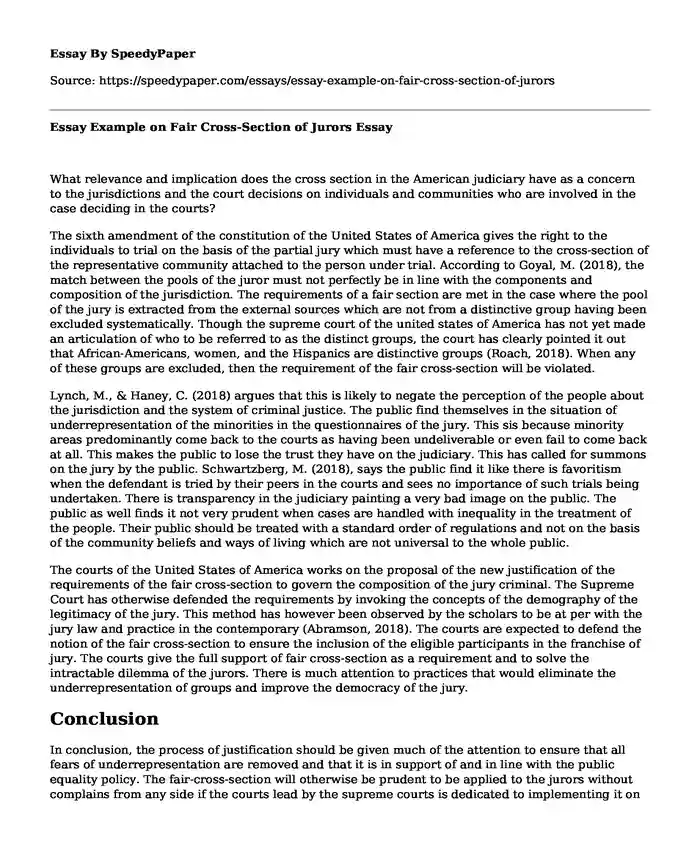
| Type of paper: | Essay |
| Categories: | Judicial system |
| Pages: | 3 |
| Wordcount: | 802 words |
What relevance and implication does the cross section in the American judiciary have as a concern to the jurisdictions and the court decisions on individuals and communities who are involved in the case deciding in the courts?
The sixth amendment of the constitution of the United States of America gives the right to the individuals to trial on the basis of the partial jury which must have a reference to the cross-section of the representative community attached to the person under trial. According to Goyal, M. (2018), the match between the pools of the juror must not perfectly be in line with the components and composition of the jurisdiction. The requirements of a fair section are met in the case where the pool of the jury is extracted from the external sources which are not from a distinctive group having been excluded systematically. Though the supreme court of the united states of America has not yet made an articulation of who to be referred to as the distinct groups, the court has clearly pointed it out that African-Americans, women, and the Hispanics are distinctive groups (Roach, 2018). When any of these groups are excluded, then the requirement of the fair cross-section will be violated.
Lynch, M., & Haney, C. (2018) argues that this is likely to negate the perception of the people about the jurisdiction and the system of criminal justice. The public find themselves in the situation of underrepresentation of the minorities in the questionnaires of the jury. This sis because minority areas predominantly come back to the courts as having been undeliverable or even fail to come back at all. This makes the public to lose the trust they have on the judiciary. This has called for summons on the jury by the public. Schwartzberg, M. (2018), says the public find it like there is favoritism when the defendant is tried by their peers in the courts and sees no importance of such trials being undertaken. There is transparency in the judiciary painting a very bad image on the public. The public as well finds it not very prudent when cases are handled with inequality in the treatment of the people. Their public should be treated with a standard order of regulations and not on the basis of the community beliefs and ways of living which are not universal to the whole public.
The courts of the United States of America works on the proposal of the new justification of the requirements of the fair cross-section to govern the composition of the jury criminal. The Supreme Court has otherwise defended the requirements by invoking the concepts of the demography of the legitimacy of the jury. This method has however been observed by the scholars to be at per with the jury law and practice in the contemporary (Abramson, 2018). The courts are expected to defend the notion of the fair cross-section to ensure the inclusion of the eligible participants in the franchise of jury. The courts give the full support of fair cross-section as a requirement and to solve the intractable dilemma of the jurors. There is much attention to practices that would eliminate the underrepresentation of groups and improve the democracy of the jury.
Conclusion
In conclusion, the process of justification should be given much of the attention to ensure that all fears of underrepresentation are removed and that it is in support of and in line with the public equality policy. The fair-cross-section will otherwise be prudent to be applied to the jurors without complains from any side if the courts lead by the supreme courts is dedicated to implementing it on fairgrounds.
The following recommendations can be put in place to realize the process:
- The formulation and the implementation should sort the contribution of the public by involving them in the consultations that since it is to them that this will be applied.
- They have people of lower socioeconomic status comply with the application of the jury; it would call for the judiciary to set a common standard that would help in governing such people by creating rooms for exceptions.
- The best practices to ensure the random selection of individuals to serve on a jury will be giving chances for applications with a restricted number of the approvals from any particular region.
References
Abramson, J. (2018). Jury Selection in the Weeds: Whither the Democratic Shore?. University of Michigan Journal of Law Reform, 52(1), 1-48.
Goyal, M. (2018). An Exception to Trial by Jury in Complex White-Collar Crime Cases. Geo. J. Legal Ethics, 31, 621.
Lynch, M., & Haney, C. (2018). Death Qualification in Black and White: Racialized Decision Making and DeathQualified Juries. Law & Policy, 40(2), 148-171.
Roach, K. (2018). The Urgent Need to Reform Jury Selection after the Gerald Stanley and Colton Boushie Case.
Schwartzberg, M. (2018). Justifying the Jury: Reconciling Justice, Equality, and Democracy. American Political Science Review, 112(3), 446-458.
Cite this page
Essay Example on Fair Cross-Section of Jurors. (2022, Dec 18). Retrieved from https://speedypaper.com/essays/essay-example-on-fair-cross-section-of-jurors
Request Removal
If you are the original author of this essay and no longer wish to have it published on the SpeedyPaper website, please click below to request its removal:
- Essay Sample on Great Depression Research
- MDS Micro Vs Supermicro/ Brown/ Dickerman - Free Essay in Antitrust Law
- American History Essay Example: The Great Migration
- Paper Example: Project Management Life Cycle Methodology
- Essay Sample on a Historical Place You Have Visited
- Dialogue on the Problem of Evil - Paper Example
- Essay Example. Comparative Rhetorical Analysis
Popular categories




